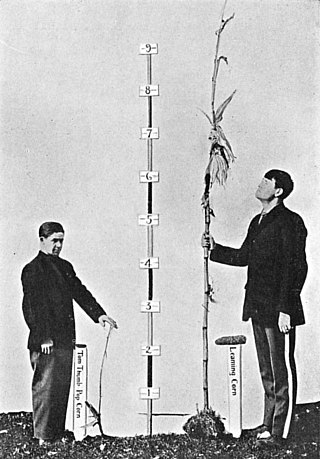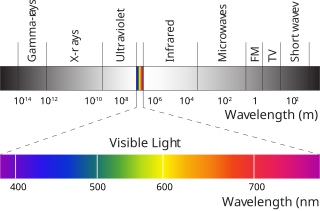Related Research Articles
Abiotic stress is the negative impact of non-living factors on the living organisms in a specific environment. The non-living variable must influence the environment beyond its normal range of variation to adversely affect the population performance or individual physiology of the organism in a significant way.

In genetics, the phenotype is the set of observable characteristics or traits of an organism. The term covers the organism's morphology, its developmental processes, its biochemical and physiological properties, its behavior, and the products of behavior. An organism's phenotype results from two basic factors: the expression of an organism's genetic code and the influence of environmental factors. Both factors may interact, further affecting the phenotype. When two or more clearly different phenotypes exist in the same population of a species, the species is called polymorphic. A well-documented example of polymorphism is Labrador Retriever coloring; while the coat color depends on many genes, it is clearly seen in the environment as yellow, black, and brown. Richard Dawkins in 1978 and then again in his 1982 book The Extended Phenotype suggested that one can regard bird nests and other built structures such as caddisfly larva cases and beaver dams as "extended phenotypes".

In botany, a stoma, also called a stomate, is a pore found in the epidermis of leaves, stems, and other organs, that controls the rate of gas exchange. The pore is bordered by a pair of specialized parenchyma cells known as guard cells that regulate the size of the stomatal opening.

Heritability is a statistic used in the fields of breeding and genetics that estimates the degree of variation in a phenotypic trait in a population that is due to genetic variation between individuals in that population. The concept of heritability can be expressed in the form of the following question: "What is the proportion of the variation in a given trait within a population that is not explained by the environment or random chance?"

Photosynthetically active radiation (PAR) designates the spectral range of solar radiation from 400 to 700 nanometers that photosynthetic organisms are able to use in the process of photosynthesis. This spectral region corresponds more or less with the range of light visible to the human eye. Photons at shorter wavelengths tend to be so energetic that they can be damaging to cells and tissues, but are mostly filtered out by the ozone layer in the stratosphere. Photons at longer wavelengths do not carry enough energy to allow photosynthesis to take place.

Gene–environment interaction is when two different genotypes respond to environmental variation in different ways. A norm of reaction is a graph that shows the relationship between genes and environmental factors when phenotypic differences are continuous. They can help illustrate GxE interactions. When the norm of reaction is not parallel, as shown in the figure below, there is a gene by environment interaction. This indicates that each genotype responds to environmental variation in a different way. Environmental variation can be physical, chemical, biological, behavior patterns or life events.
In ecology and genetics, a reaction norm, also called a norm of reaction, describes the pattern of phenotypic expression of a single genotype across a range of environments. One use of reaction norms is in describing how different species—especially related species—respond to varying environments. But differing genotypes within a single species may also show differing reaction norms relative to a particular phenotypic trait and environment variable. For every genotype, phenotypic trait, and environmental variable, a different reaction norm can exist; in other words, an enormous complexity can exist in the interrelationships between genetic and environmental factors in determining traits. The concept was introduced by Richard Woltereck in 1909.

Phenotypic plasticity refers to some of the changes in an organism's behavior, morphology and physiology in response to a unique environment. Fundamental to the way in which organisms cope with environmental variation, phenotypic plasticity encompasses all types of environmentally induced changes that may or may not be permanent throughout an individual's lifespan.
Phenomics is the systematic study of traits that make up a phenotype. It was coined by UC Berkeley and LBNL scientist Steven A. Garan. As such, it is a transdisciplinary area of research that involves biology, data sciences, engineering and other fields. Phenomics is concerned with the measurement of the phenotype where a phenome is a set of traits that can be produced by a given organism over the course of development and in response to genetic mutation and environmental influences. It is also important to remember that an organisms phenotype changes with time. The relationship between phenotype and genotype enables researchers to understand and study pleiotropy. Phenomics concepts are used in functional genomics, pharmaceutical research, metabolic engineering, agricultural research, and increasingly in phylogenetics.
Ecophysiology, environmental physiology or physiological ecology is a biological discipline that studies the response of an organism's physiology to environmental conditions. It is closely related to comparative physiology and evolutionary physiology. Ernst Haeckel's coinage bionomy is sometimes employed as a synonym.
Specific leaf area (SLA) is the ratio of leaf area to leaf dry mass. The inverse of SLA is Leaf Mass per Area (LMA).
"Envirome" is a concept that relates the core of environmental conditions with the successful biological performance of living beings. This concept was created in genetic epidemiology, in which an envirome is defined as the total set of environmental factors, both present, and past, that affect the state, and in particular the disease state, of an organism. The study of the envirome and its effects is termed enviromics. The term was first coined in the field of psychiatric epidemiology by J.C. Anthony in 1995. More recently, use of the term has been extended to the cellular domain, where cell functional enviromics studies both the genome and envirome from a systems biology perspective. In plants, enviromics is directly related to complex ecophysiology, in which the wide environment of the plants, into an omics scale, can be dissected and understood as a mosaic of possible growing factors and the balance of diverse resources available. In ecology, this concept can be related to the Shelford's law of tolerance. The enviromics is conceived as a pillar of the Modern Plant Breeding, capable to connect the design and development of breeding goals concealing it with the agronomic targets for a climate-smart agriculture. It also has the ability to bridge the knowledge gaps between the different levels of systems biology and phenomics in the context of Gene–environment interaction.
Biomass partitioning is the process by which plants divide their energy among their leaves, stems, roots, and reproductive parts. These four main components of the plant have important morphological roles: leaves take in CO2 and energy from the sun to create carbon compounds, stems grow above competitors to reach sunlight, roots absorb water and mineral nutrients from the soil while anchoring the plant, and reproductive parts facilitate the continuation of species. Plants partition biomass in response to limits or excesses in resources like sunlight, carbon dioxide, mineral nutrients, and water and growth is regulated by a constant balance between the partitioning of biomass between plant parts. An equilibrium between root and shoot growth occurs because roots need carbon compounds from photosynthesis in the shoot and shoots need nitrogen absorbed from the soil by roots. Allocation of biomass is put towards the limit to growth; a limit below ground will focus biomass to the roots and a limit above ground will favor more growth in the shoot.
Daily light integral (DLI) describes the number of photosynthetically active photons that are delivered to a specific area over a 24-hour period. This variable is particularly useful to describe the light environment of plants.
Genetic variance is a concept outlined by the English biologist and statistician Ronald Fisher in his fundamental theorem of natural selection. In his 1930 book The Genetical Theory of Natural Selection, Fisher postulates that the rate of change of biological fitness can be calculated by the genetic variance of the fitness itself. Fisher tried to give a statistical formula about how the change of fitness in a population can be attributed to changes in the allele frequency. Fisher made no restrictive assumptions in his formula concerning fitness parameters, mate choices or the number of alleles and loci involved.

The CO2 fertilization effect or carbon fertilization effect causes an increased rate of photosynthesis while limiting leaf transpiration in plants. Both processes result from increased levels of atmospheric carbon dioxide (CO2). The carbon fertilization effect varies depending on plant species, air and soil temperature, and availability of water and nutrients. Net primary productivity (NPP) might positively respond to the carbon fertilization effect. Although, evidence shows that enhanced rates of photosynthesis in plants due to CO2 fertilization do not directly enhance all plant growth, and thus carbon storage. The carbon fertilization effect has been reported to be the cause of 44% of gross primary productivity (GPP) increase since the 2000s. Earth System Models, Land System Models and Dynamic Global Vegetation Models are used to investigate and interpret vegetation trends related to increasing levels of atmospheric CO2. However, the ecosystem processes associated with the CO2 fertilization effect remain uncertain and therefore are challenging to model.
The photothermal ratio (PTR), also named photothermal quotient, is a variable that characterizes the amount of light available to plants relative to the temperature level. It is used in plant biology to characterize the growth environment of plants.
Biomass allocation is a concept in plant biology which indicates the relative proportion of plant biomass present in the different organs of a plant. It can also be used for whole plant communities.
Plant growth analysis refers to a set of concepts and equations by which changes in size of plants over time can be summarised and dissected in component variables. It is often applied in the analysis of growth of individual plants, but can also be used in a situation where crop growth is followed over time.
Temporal plasticity, also known as fine-grained environmental adaptation, is a type of phenotypic plasticity that involves the phenotypic change of organisms in response to changes in the environment over time. Animals can respond to short-term environmental changes with physiological (reversible) and behavioral changes; plants, which are sedentary, respond to short-term environmental changes with both physiological and developmental (non-reversible) changes.
References
- ↑ "Plant Meta-Phenomics". www.metaphenomics.org.
- ↑ Poorter, Hendrik; Niinemets, Ülo; Walter, Achim; Fiorani, Fabio; Schurr, Uli (May 2010). "A method to construct dose–response curves for a wide range of environmental factors and plant traits by means of a meta-analysis of phenotypic data" (PDF). Journal of Experimental Botany. 61 (8): 2043–2055. doi: 10.1093/jxb/erp358 .
- ↑ Poorter, Hendrik; Niinemets, Ülo; Poorter, Lourens; Wright, Ian J.; Villar, Rafael (16 April 2009). "Causes and consequences of variation in leaf mass per area (LMA): a meta‐analysis". New Phytologist. 182 (3): 565–588. doi:10.1111/j.1469-8137.2009.02830.x.
- ↑ Esteban, Raquel; Barrutia, Oihana; Artetxe, Unai; Fernández-Marín, Beatriz; Hernández, Antonio; García-Plazaola, José Ignacio (April 2015). "Internal and external factors affecting photosynthetic pigment composition in plants: a meta-analytical approach". New Phytologist. 206 (1): 268–280. doi:10.1111/nph.13186.
- ↑ Poorter, Hendrik; Niinemets, Ülo; Ntagkas, Nikolaos; Siebenkäs, Alrun; Mäenpää, Maarit; Matsubara, Shizue; Pons, ThijsL. (8 April 2019). "A meta‐analysis of plant responses to light intensity for 70 traits ranging from molecules to whole plant performance". New Phytologist. doi: 10.1111/nph.15754 .